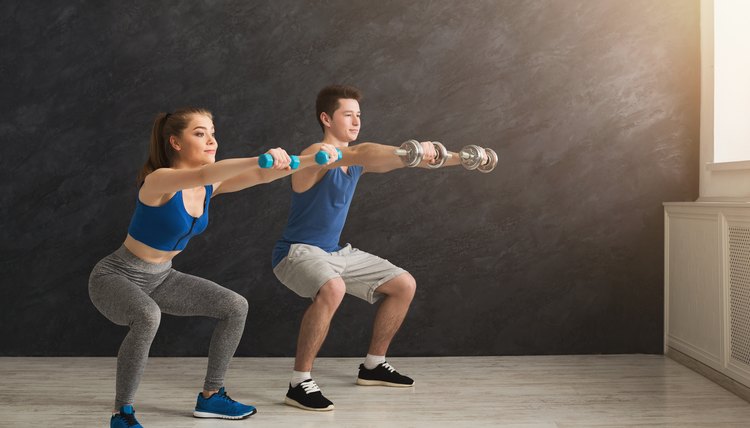What does fact checked mean?
At SportsRec, we strive to deliver objective content that is accurate and up-to-date. Our team periodically reviews articles in order to ensure content quality. The sources cited below consist of evidence from peer-reviewed journals, prominent medical organizations, academic associations, and government data.
- American Heart Association: Recommendations For Physical Activity In Adults
- ACE: 8 Things to Know About Aerobic Capacity (And How to Improve It)
- Journal of Sports Science and Medicine: The Effects of High Intensity Interval Training vs Steady State Training on Aerobic and Anaerobic Capacity
- Journal of Sports Science and Medicine: The Effects of High Intensity Interval Training vs Steady State Training on Aerobic and Anaerobic Capacity
The information contained on this site is for informational purposes only, and should not be used as a substitute for the advice of a professional health care provider. Please check with the appropriate physician regarding health questions and concerns. Although we strive to deliver accurate and up-to-date information, no guarantee to that effect is made.
Hindu Squats: The Aerobic Exercise Benefits

One way to improve aerobic fitness is by engaging in long bouts of repetitive movements that work many of the muscles in the body at one time. This is called aerobic exercise, and running is a classic example.
Hindu squats, like its cousin hindu pushups, are a classic addition to a workout routine from India. They are a strength-training exercise, meaning you do them in sets for a limited period of time. Both draw on the aerobic energy system and can influence aerobic fitness, but running is far better at increasing aerobic capacity. The exercise was popularized by Indian wrestlers and the bodybuilding community.
What is Aerobic Fitness?
Aerobic fitness is your body's ability to convert oxygen from the air into energy. The oxygen you inhale while you're running has to make it to the muscles in order for your muscles to keep up activity. That's where your heart comes in. Your heart pumps fresh blood to all your muscles, which not only supplies necessary nutrients but also oxygen. Your muscles use that oxygen to break down glucose and fats into adenosine-triphosphate, or ADP -- the main source of cellular energy.
The more effectively your heart can pump blood throughout your body, the better able you are to sustain activity. As you run, your heart rate rises in order to get more oxygenated blood to your muscles. With continued aerobic exercise, your heart gets stronger, able to pump more blood to your muscles more efficiently. Your heart doesn't have to beat as hard to move blood, and aerobic exercise feels easier.
How to do Hindu Squats?
Doing Hindu squats is much different than regular squats. First, get in the standing position with your feet shoulder width apart. Then, extend your arms straight out in front of your chest and lower your hips back and down toward the floor. Then, lift your heels off the floor and reach your arms behind you with your back straight. Then touch your heels and go back up to start position. Many beginners should do this as a bodyweight squat before moving up to a barbell or dumbbell.
Duration Matters
The duration is the main factor that characterizes aerobic exercise. Doing a sustained series of fast Hindu squats over an extended period of time could be a cardiovascular workout -- if you could do them for long enough. However, this is an intensive exercise, of which the average person could only sustain about 12 to 25 repetitions or reps. If you are using just your body weight you might be able to do more, but not for more than two minutes without resting.
Running on the other hand is something that people who have a moderate level of cardiovascular fitness can do for a longer period of time. Many people jump on the treadmill for 30 minutes, or go out for a 5-mile jog. These longer periods of exertion train the heart and lungs to work more effectively and efficiently for the long haul.
Benefits of Hindu Squats
Hindu squats also require energy, so they do impact aerobic fitness to some extent, but not by much. They're still worthwhile, though. They strengthen muscle groups like the hamstrings, glutes, quads and calves, as well as your core muscles and lower back. Strengthening your muscles helps the body become more efficient at consuming and using oxygen.
In addition, balancing on your toes works the small stabilizer muscles of your lower body and core that keep you from falling. As a result Hindu squats are one of the best exercises to improve your balance and coordination.
High-intensity Interval Training
Another activity that improves your aerobic fitness involves repeating working intervals at a very high intensity for a short period of time, then recovering at a lower intensity. This type of training can improve your aerobic capacity as well as steady-state cardio, and potentially in less time. You can sprint instead of run for one minute, then recover for one to two minutes. Repeat these intervals several more times.
You can also work resistance exercises, such as Hindu squats, into your interval workout. Try doing a set of 12 to 15 reps of Hindu squats, then sprinting for one minute, followed by two minutes of recovery. Repeat this series several more times. Your legs will feel the burn as your heart gets stronger.
Explore In Depth
References
Writer Bio
Louise D E Jensen has written professionally since 1991. She has authored more than 12 books, has appeared on CTV news as a fitness and nutrition expert, and is featured in the "Globe and Mail." She holds degrees in dietetics and epidemiology from the University of British Colombia and the University of Toronto.
